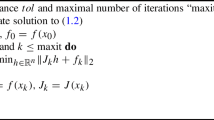Abstract
The problem of finding sparse solutions to underdetermined systems of linear equations is very common in many fields as e.g. signal/image processing and statistics. A standard tool for dealing with sparse recovery is the \(\ell _1\)-regularized least-squares approach that has recently attracted the attention of many researchers. In this paper, we describe a new version of the two-block nonlinear constrained Gauss–Seidel algorithm for solving \(\ell _1\)-regularized least-squares that at each step of the iteration process fixes some variables to zero according to a simple active-set strategy. We prove the global convergence of the new algorithm and we show its efficiency reporting the results of some preliminary numerical experiments.




Similar content being viewed by others
Explore related subjects
Discover the latest articles and news from researchers in related subjects, suggested using machine learning.References
Afonso, M.V., Bioucas-Dias, J.M., Figueiredo, M.A.T.: Fast image recovery using variable splitting and constrained optimization. IEEE Trans. Image Process. 19(9), 2–45 (2010)
Beck, A., Teboulle, M.: A fast iterative shrinkage–threshold algorithm for linear inverse problems. SIAM J. Imaging Sci. 2, 183–202 (2009)
Bertsekas, D.P.: Nonlinear Programming, 2nd edn. Athena Scientific, Belmont (1999)
Bioucas-Dias, J., Figueiredo, M.: A new twist: two-step iterative shrinkage/thresholding algorithms for image restoration. IEEE Trans. Image Process. 16, 2992–3004 (2007)
Bruckstein, A.M., Donoho, D.L., Elad, M.: From sparse solutions of systems of equations to sparse modeling of signals and images. SIAM Rev. 51(1), 34–81 (2009)
Candès, E., Romberg, J., Tao, T.: Robust uncertainty principles: exact signal reconstruction from highly incomplete frequency information. IEEE Trans. Inf. Theory 52(2), 489–509 (2006)
Candès, E., Romberg, J.: Quantitative robust uncertainty principles and optimally sparse decompositions. Found. Comput. Math. 6(2), 227–254 (2006)
Candès, E., Romberg, J., Tao, T.: Stable signal recovery from incomplete and inaccurate measurements. Commun. Pure Appl. Math. 59(8), 1207–1223 (2006)
Chen, S.S., Donoho, D.L., Saunders, M.A.: Atomic decomposition basis pursuit. SIAM Rev. 43, 129–159 (2001)
Daubechies, I., Defrise, M., Mol, C.D.: An iterative thresholding algorithm for linear inverse problems with sparsity constraints. Commun. Pure Appl. Math. 57, 1413–1457 (2004)
Dolan, E.D., Moré, J.J.: Benchmarking optimization software with performance profiles. Math. Program 91, 201221 (2002)
Donoho, D.: Compressed sensing. IEEE Trans. Inf. Theory 52(4), 1289–1306 (2006)
Facchinei, F., Fischer, A., Kanzow, C.: On the accurate identification of active constraints. SIAM J. Optim. 9, 14–32 (1999)
Figueiredo, M., Nowak, R., Wright, S.: Gradient projection for sparse reconstruction: application to compressed sensing and other inverse problems. IEEE J. Sel. Top. Signal Process. 1, 586–598 (2007)
Fletcher, R.: A class of methods for nonlinear programming with termination and convergence properties. In: Abadie, J. (ed.) Integer and Nonlinear Programming, pp. 157–175. North-Holland, The Netherlands (1970)
Fountoulakis, K., Gondzio, J., Zhlobich, P.: Matrix-free interior point method for compressed sensing problems. Math. Program. Comput. 6(1), 1–31 (2014)
Grippo, L., Sciandrone, M.: Globally convergent block-coordinate techniques for unconstrained optimization. Optim. Methods Softw. 10(4), 587–637 (1999)
Grippo, L., Sciandrone, M.: On the convergence of the block nonlinear Gauss–Seidel method under convex constraints. Oper. Res. Lett. 26(3), 127–136 (2000)
Hale, E.T., Yin, W., Zhang, Y.: A numerical study of fixed-point continuation applied to compressed sensing. J. Comput. Math. 28(2), 170194 (2010)
Haynsworth, E.V.: On the Schur Complement. Basel Mathematical Notes, BNB 20. Wiley, Hoboken (1968)
Hestenes, M.R.: Multiplier and gradient methods. J. Optim. Methods Appl. 4, 303–320 (1969)
Kim, S.-J., Koh, K., Lustig, M., Boyd, S., Gorinevsky, D.: An interior-point method for large-scale l1-regularized least squares. IEEE J. Sel. Top. Signal Process. 1(4), 606–617 (2007)
Powell, M.J.D.: A method for nonlinear constraints in minimization problems. In: Fletcher, R. (ed.) Optimization, pp. 283–298. Academic Press, New York (1969)
Tibshirani, R.: Regression shrinkage and selection via the Lasso. J. R. Stat. Soc. Ser. B 58(1), 267–288 (1996)
Tseng, P., Yun, S.: A coordinate gradient descent method for nonsmooth separable minimization. Math. Program. 117(1), 387–423 (2009)
Wen, Z., Yin, W., Goldfarb, D., Zhang, Y.: A fast algorithm for sparse reconstruction based on shrinkage, subspace optimization and continuation. SIAM J. Sci. Comput. 32(4), 1832–1857 (2010)
Wen, Z., Yin, W., Zhang, H., Goldfarb, D.: On the convergence of an active-set method for \(\ell _1\) minimization. Optim. Methods Softw. 27(6), 1127–1146 (2012)
Wright, S., Nowak, R., Figueiredo, M.: Sparse reconstruction by separable approximation. IEEE Trans. Signal Process. 57, 2479–2493 (2009)
Zhang, J.J., Morini, B.: Solving regularized linear least-squares problems by alternating direction methods with applications to image restoration. Electron. Trans. Numer. Anal. (ETNA) 40, 356–372 (2013)
Acknowledgments
The authors thank anonymous referees for useful comments that helped to improve the manuscript. The second author would also like to thank Professor Luigi Grippo for kindly sharing with him many ideas and insights that led to this paper. The work of the first author was supported by “National Group of Computing Science (GNCS-INDAM)”.
Author information
Authors and Affiliations
Corresponding author
Appendix
Appendix
In Tables 1, 2 and 3, we report the average CPU time (Av-CPU), the average relative error (Av-rel.err.) and the average number on nonzero components of the computed solution (Av-nnz), corresponding to runs summarized in the performance profiles in Figs. 2 and 3. Problems where the false termination of FPC-AS with the criterion (40) occurs 1 over 10 runs is denoted with the symbol ‘*’ and the average values reported in the tables do not take into account these cases.
Rights and permissions
About this article
Cite this article
Porcelli, M., Rinaldi, F. A variable fixing version of the two-block nonlinear constrained Gauss–Seidel algorithm for \(\ell _1\)-regularized least-squares. Comput Optim Appl 59, 565–589 (2014). https://doi.org/10.1007/s10589-014-9653-0
Received:
Published:
Issue Date:
DOI: https://doi.org/10.1007/s10589-014-9653-0
Keywords
Profiles
- Margherita Porcelli View author profile




